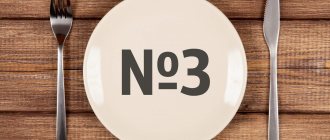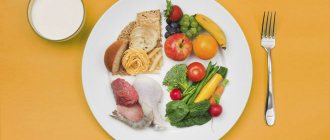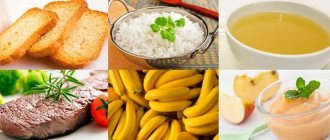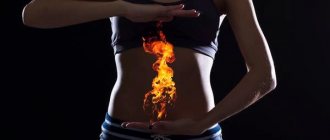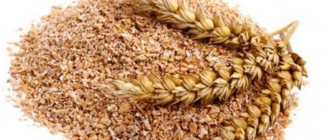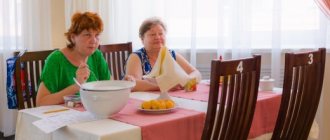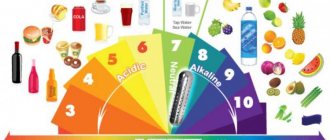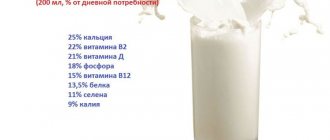The founder of gastroenterology and diet therapy in the USSR is considered to be the therapist, one of the organizers of the Institute of Nutrition in Moscow, Manuil Pevzner. The dietary nutrition system that he developed is aimed at treating certain diseases and is called the “table”. Nutrition programs according to Pevzner have been successfully used by doctors since the middle of the last century.
Let us consider in detail the second diet from this list, which is used for chronic diseases of the stomach and intestines, in particular, chronic gastritis with secretory insufficiency. Table No. 2 can be used for enteritis and colitis not only during the period of restoration of intestinal function, but also during the period of exacerbation. Another such diet is often prescribed after operations in the rehabilitation phase, as well as during the recovery phase after infectious diseases. We will learn what you need to eat and in what form, what you can prepare, and how to create a menu.
The essence and purpose of the diet
Treatment table No. 2, as a rule, is used in the period after an exacerbation of the inflammatory process of the stomach and intestines; before that, diet No. 1 is used. It is important to know that such a diet may not be suitable for patients with concomitant diseases of the pancreas, liver and gallbladder.
Therefore, such a diet should be prescribed exclusively by a gastroenterologist based on the general condition of the patient and the results of laboratory and instrumental tests. : If the patient's condition worsens and the symptoms of the disease progress, the doctor prescribes a different course of treatment and diet.
Content:
- The essence and purpose of the diet
- Eating on a diet
- Menu for table No. 2
- Dietary dishes for table No. 2
- Finally
The goal of this program is to stimulate the normal secretion of digestive enzymes. With the virtual absence or insufficient production of digestive juices, the normal process of digestion is impossible.
That is why the goal of diet therapy using table No. 2 is to restore digestive function. In addition, during therapeutic nutrition, the motility of the digestive tract improves. Gastrointestinal motility ensures the movement of food through the digestive tract and its mixing with gastric juice. Violations of this function are also dangerous and extremely undesirable.
Table number 2 is characterized as a complete and balanced diet. The list of prohibited foods includes hard-to-digest, fatty and spicy foods. Almost all types of heat treatment are allowed. The patient must eat at least 2800 kcal per day, this is the daily caloric intake for an ordinary person. That is, you don’t have to starve or severely restrict yourself, and it’s not even allowed. Particular attention is paid here to mechanical sparing.
The chemical composition of the diet should consist of all the vitamins and microelements the body needs. Every day you need to consume approximately 100 g of proteins and fats, both vegetable and animal, and supplement with 400 g of carbohydrates.
To accurately navigate the amount of components consumed, it is better to find recipes indicating the content of proteins, fats, carbohydrates, as well as calorie content per 100 g of dish or food product. Such recipes are most common on websites for athletes and health portals. In general, you need to eat a little of everything a day: dietary meats, poultry, white fish, cereals, vegetables, fruits. It is recommended to eat plant foods not raw, but cooked. You also need to limit the amount of salt - no more than 15 grams per day.
Mechanical processing of dishes for table No. 2: food should be finely chopped, pureed, soft, mushy. Lean fish fillets do not need to be chopped; the main thing is to eat them without skin. Everything else should be in the form of baby food, soups - not rich and liquid (not bone and with a second broth), porridge - pureed, fillets for cutlets and meatballs - it is better to pass through a meat grinder several times.
Heat treatment: the diet should consist of approximately 80% boiled or steamed foods. Food can also be baked, stewed or fried. The main thing is that there is no thick crust. When frying, it is not allowed to use breading in breadcrumbs or batter with flour. The food consumed should only be warm: not very cold and not too hot. It is also not allowed to overeat; there should be 4-5 moderate servings per day.
So, to recover from gastritis and related diseases, you need to eat warm, soft food, divided into 4-5 meals. You can't overeat and starve. The basis of the diet should be cooked ingredients.
general characteristics
The “2 table” diet provides complete nutrition, moderately stimulates the secretory function of the digestive organs and normalizes the motor function of the gastrointestinal tract.
General characteristics:
a physiologically complete diet with moderate mechanical sparing and moderate stimulation of the secretion of the digestive organs. Dishes of varying degrees of grinding and heat treatment are allowed - boiled, stewed, baked, fried without forming a rough crust (without breading in breadcrumbs or flour). Puree dishes are made from foods rich in connective tissue or fiber. Avoid foods and dishes that linger in the stomach for a long time, are difficult to digest, irritate the mucous membrane of the gastrointestinal tract, and very cold and hot dishes.
Chemical composition and calorie content:
- carbohydrates - 400-420 g,
- proteins - 90-100 g (60% animals),
- fats – 90-100 (25% vegetable),
- calories - 2800-3000 kcal,
- sodium chloride - up to 15 g,
- free liquid - 1.5 l.
Diet:
4-5 times a day without large meals.
Eating on a diet
Flour for baking should be 1st 2nd milling and only made from wheat. Baked goods must be dried, baked the day before use. Once every three to four days you can eat pies or dried pies; the filling must be made from acceptable ingredients.
It is forbidden:
- puff pastries and cookies;
- baked goods;
- dark bread;
- hot pastries.
Be sure to eat liquid food at least once a day. Broths for first courses can be made with mushrooms or vegetables. It is not prohibited to use vermicelli, finely chopped vegetables, and permitted cereals for the first one. If meat is used for the broth, it must be boiled twice, and the soup should be cooked in secondary broth. Use only lean meats. Light fish soup made from lean fish and borscht (with a minimum content of white cabbage) are also allowed.
The first one is not allowed with:
- with milk or kefir;
- beans;
- strong broth;
- with millet.
Lean meat without layers of fat and skin is allowed. Boiled tongue and natural sausages are allowed (milk sausages are possible). You can cook rabbit, chicken, turkey, young beef, and game. Lamb and pork are limited (possible, but as little as possible). Fish with white, lean meat is suitable: crucian carp, hake, cod, etc.
It is forbidden:
- old lamb, beef, streaky pork, goose, duck;
- other types of meat and fish, smoked or raw;
- canned food, marinades.
Cereals (except those prohibited) can be added to diet cutlets, puddings, and baked pancakes. You can use water as a base for porridge or add a third of milk to it. They must be ground before serving. Millet can be eaten up to 2 times a week.
It is forbidden:
- barley;
- barley;
- corn;
- all types of beans.
Plant food. Only fully ripe fruits are allowed. Several times a week (if well tolerated) green peas are introduced into the diet. Mousses, purees, jelly, steamed vegetables, lean roasts, smoothies are served in pureed form (after heat treatment).
Do not use:
- bell pepper;
- radishes and radishes;
- mushrooms;
- garlic;
- cucumbers;
- onion.
Among fruits and berries, fruits with rough skin and seeds are prohibited: figs, dates. Raspberries, currants and gooseberries are also not used.
Eggs. You can use any: quail, chicken, turkey, goose. If you are frying fried eggs or omelettes, do not allow a crust to form. You can cook it soft-boiled, steamed or poached.
Don't: Hard-boiled eggs.
Milk products. Low-fat milk, kefir, yogurt, natural yoghurts without additives. You can use a little grated hard cheese. Cottage cheese can be used for dishes or eaten in its natural form. You can add cream and a little sour cream to drinks and food (15 g per dish).
It is forbidden:
- fatty milk products;
- cheeses with nuts, high salt content or spicy ones.
Drinks – light coffee and cocoa. You can use weak decoctions and teas, sometimes with lemon. Natural juices from fruits, berries and vegetables should be diluted with clean water. It is recommended to periodically consume a decoction of bran (it has an enveloping effect on the inflamed mucous membrane of the stomach and intestines, and mild stimulation of motility). Also, a herbal decoction of rose hips has a very good effect on digestion, which in addition has a vascular strengthening effect.
Do not use:
- carbonated drinks;
- alcoholic drinks;
- grape juice.
Dessert. Baked fruits, boiled berry purees, dried fruits, and pureed dried fruits are not prohibited. Buckwheat or May honey is added to dishes, teas and infusions. Natural nougat, jam, marshmallows, liquid preserves, meringues and marmalade are allowed. You can also drink sweet decoctions based on fruits and berries, jelly.
It is forbidden:
- fresh baked goods;
- chocolate and cream products;
- cold desserts;
- yoghurts with additives.
Hot, sour and fatty spices and sauces are also prohibited: mustard, adjika, ketchup, mayonnaise, horseradish. Animal and cooking fats should not be used for cooking: margarine, spread, lard, etc. You can add finely chopped greens to dishes.
Let's look at a sample menu for a week to make it easier to navigate the treatment program.
Excluded foods and dishes of the diet table No. 2
Foods that cause fermentation processes in the gastrointestinal tract and foods that mechanically irritate the stomach should be excluded from the diet. Excluded are fresh bread and products made from butter and puff pastry, okroshka, legume soups, milk soups, fatty meats, pickles, smoked foods, canned food, marinades, seasonings, sauces, carbonated drinks (including kvass). Also exclude sharp cheeses, coarse cereals (millet, corn, barley and pearl barley), hard-boiled eggs, sorrel, onions, cucumbers, tomatoes, legumes, white cabbage, spinach, turnips, radishes, radishes, paprika, garlic, mushrooms, sour fruits and berries. Avoid eating chocolate and rich pastry creams.
Menu for table No. 2
Since the list of allowed products contains almost all the necessary ingredients, creating a menu will not be difficult. Also, there are practically no restrictions for heat treatment: any available methods, except for heavily fried. You can make individual adjustments and dishes to the menu, focusing on the rules of the therapeutic course.
Monday
Breakfast: boiled eggs, fruit jelly, coffee with milk.
Lunch: soup with beef, potatoes, noodles and herbs.
Afternoon snack: natural yogurt, honey apple in the oven.
Dinner: buckwheat with stewed chicken meatballs.
Before bed: natural yogurt.
Tuesday
Breakfast: cheese omelette made from proteins, coffee with cream and sugar.
Lunch: tomato soup, a portion of mashed potatoes.
Afternoon snack: tea with crackers.
Dinner: soft rice and fish quenelles.
Before bed: kefir.
Wednesday
Breakfast: light semolina with the addition of finely chopped dried apricots, coffee.
Lunch: soup with boiled cereals and vegetables, dried bread.
Afternoon snack: strawberry broth, homemade jelly.
Dinner: lean vegetable roast, separately a piece of boiled veal.
Before bed: yogurt.
Thursday
Breakfast: fried eggs, boiled milk sausage, coffee with milk.
Lunch: lean fish broth, dried bread.
Afternoon snack: semolina pudding, tea.
Dinner: diet steamed chicken cutlets with a side dish of vermicelli.
Before bed: kefir.
Friday
Breakfast: cocoa, oatmeal with milk.
Lunch: beetroot without meat, bread.
Afternoon snack: tea with marmalade.
Dinner: quenelles in sour cream sauce, some soft rice.
Before bed: natural yogurt.
Saturday
Breakfast: boiled sausage, eggs, coffee with cream.
Lunch: cream soup with chicken and broccoli or cauliflower.
Afternoon snack: honey and dried cookies, tea.
Dinner: baked cod without skin, carrot puree.
Before bed: yogurt.
Sunday
Breakfast: sandwiches made from wheat bread with hard cheese, coffee with milk.
Lunch: rassolnik (brine instead of cucumbers).
Afternoon snack: baked pear with powdered sugar, tea.
Dinner: noodle soup with minced meat, juice and water.
Before bed: kefir.
It is important to drink a normal amount of purified water throughout the day, most importantly not during meals. Water dilutes gastric juice and food is not digested normally. After eating, you need to wait 15-20 minutes and only then drink water. It is recommended to drink a glass of fermented milk drinks at night. You can use salt for cooking, but in minimal quantities. Strict adherence to all diet rules ensures a speedy recovery and transition to a nutritious diet.
Dietary table recipes No. 2:
- pureed rice soup
- fresh cabbage soup
- borsch
- cutlets without breading
- baked meat
- fish cutlets
- crumbly buckwheat porridge
- vegetable stew
- sour cream sauce
- soft-boiled egg
- rosehip decoction
- fruit mousse
- mashed potatoes
- steam omelette
- baked apple with sugar
- apple jelly
- Steam curd soufflé
- fruit jelly
- rice pudding
- fruit sauce
- salad of boiled vegetables and boiled sausage
- berry mousse
- baked pear with sugar
- boiled pike perch
- meat soufflé
- fish aspic
Photos used in this material belong to shutterstock.com
Dietary dishes for table No. 2
A wide list of products allows you to show your imagination in creating a diet. Despite the fact that the food system is medicinal, there can be many options for dishes: puddings, casseroles, stews, soups, desserts and much more. As an example, let's look at some recipes for table No. 2.
Oatmeal pudding is suitable for breakfasts, afternoon snacks and as a main course.
To prepare, boil 2 cups of oatmeal with milk and sugar and leave to cool. At this time, grate the pumpkin (one cup). Place the pumpkin in a frying pan, add one glass of milk and simmer until tender. Mix both masses. Beat 2 egg whites until foamy and add to the pumpkin mixture, stirring constantly. Place the resulting dough in a greased pan, spread sour cream on top and bake until done. You can check the degree of readiness using a toothpick.
Fish pate is suitable for breakfast sandwiches or snacks.
One boiled carrot and 100 g of cottage cheese need to be ground until smooth. Separately, boil 200 g of cod fillet (you can use hake), pass it through a meat grinder and simmer the minced meat until the moisture evaporates. Combine both masses and beat well.
Kissel with dried apricots is great as a dessert or drink. You can take it in a thermos to work or for a walk.
Dried apricots (any amount) need to be boiled in water for 30 minutes. Then wipe the dried fruits and return them to the broth. Separately, mix starch with clean water (1:4), at the rate of 15 g of starch per 200 ml of broth. Introduce starch solution into a boiling broth with pureed dried apricots in a thin stream and immediately turn off. If the jelly is placed in portioned dishes (cremankas, glasses), sprinkle it with powdered sugar on top to prevent a crust from forming.
Best materials of the month
- Coronaviruses: SARS-CoV-2 (COVID-19)
- Antibiotics for the prevention and treatment of COVID-19: how effective are they?
- The most common "office" diseases
- Does vodka kill coronavirus?
- How to stay alive on our roads?
Chemical composition and energy value of dietary table No. 2
Proteins: 90–100 g (45% animal proteins). Fats: 80–85 g (30% vegetable fats). Carbohydrates: 350 g (no more than 40 g of simple carbohydrates). Daily calorie content: 2,200 – 2,400 kcal. Free liquid: 1.5–2 l. Table salt: 6–8 g. Vitamins: retinol (A) 2 mg, riboflavin (B2) 4 mg, thiamine (B1) 4 mg, nicotinic acid (B3) 30 mg, ascorbic acid (C) 100 mg. Macroelements: calcium 0.8 g, magnesium 0.5 g, phosphorus 1.2 g. Microelements: iron 15 mg. Optimal food temperature: from 15 to 65 degrees Celsius.
Nutrition during an exacerbation
In case of exacerbation of chronic gastritis - within several days - the patient is recommended to follow diet No. 1A and No. 1B. Nutrition minimizes the negative impact of food on the inflamed gastric mucosa. Treatment table No. 1A is physiologically inferior and has a reduced caloric intake: a person receives no more than 2000 Kcal per day. The volume of table salt is 8 grams.
Products/dishes that can enhance the secretory function of the stomach and irritate its surface are completely excluded from the menu. The food served should be moderately warm, but in no case hot or cold. Dishes should have a liquid consistency, which facilitates the digestion process. You need to eat fractionally - up to 6 times a day - in small portions so as not to overload the stomach.
During an exacerbation, you should not eat:
- bread;
- sour cream;
- cheese products;
- fat meat;
- sour milk;
- cottage cheese;
- fresh vegetables/fruits;
- seasonings/spices;
- strong brewed teas;
- carbonated drinks.
In case of exacerbation of gastritis, the patient is prescribed diet No. 1A.
The patient is transferred to therapeutic diet No. 1B on the fourth or fifth day from the onset of the disease - when the pathological symptoms subside. Daily caloric intake – up to 2500 Kcal. The diet is characterized by a reduced carbohydrate content, but the protein content meets physiological needs.
What can you include in your diet? The menu is expanding due to the introduction of new products. These are homemade crackers, slimy cereal soups, boiled, pureed dietary meat, dairy products, soft-boiled eggs, white fish, boiled vegetables, sweet juices, previously diluted with water. The duration of diet No. 1B is three to five days. Then the patient is transferred to table No. 1.
Table No. 5
Nutrition for chronic gastritis, which is not accompanied by pronounced changes in the gastric mucosa, can be carried out in accordance with treatment table No. 5. Proper nutrition is represented by the following products and dishes:
- Soups. For cooking, you can only use vegetable broths thickened with cereals, vegetables or noodles. Cabbage soup, borscht, and fruit/dairy dishes are allowed. Vegetable dressing cannot be fried.
- White flour bread. If tolerated well, black (rye) is allowed. You can eat dry biscuits, biscuits, and savory pastries.
- Meat of dietary grades.
- Low-fat fish - hake, cod, carp, blue whiting and others. It is baked, boiled, or cooked in a double boiler.
- Eggs in the form of an omelet or cooked soft-boiled. The product is prohibited if you have cholelithiasis.
- Low-fat dairy products - kefir, yogurt. It is recommended to add milk to an already prepared dish. Casseroles are prepared from cottage cheese.
- Sour cream and butter. Added to prepared dishes.
- Cereals (any). They are used to cook porridge and add to soups.
- Vegetables. They are baked, boiled, stewed. You can prepare salads and vinaigrette.
- Sauces – vegetable, dairy, sour cream.
- Sweet tasting berries and fruits. Served fresh, used for making jelly and compotes.
- Sweets – marmalade, caramels, jam, honey.
- Drinks – still water, weakly brewed tea, rosehip drink, bran decoction.
The following must be excluded from the menu:
- baked goods, fresh bread;
- sorrel, spinach - contain oxalic acid, so they can worsen overall health;
- onion, garlic, radish, radish;
- meat, fatty fish, including salted fish;
- canned food;
- smoked meats;
- strong broths;
- okroshka, sauerkraut cabbage soup;
- offal - liver, brains, kidneys;
- high fiber vegetables;
- duck, goose;
- scrambled and hard-boiled eggs;
- animal fats;
- fat milk, cream;
- seasonings with a spicy taste;
- cocoa, chocolate, black coffee.
Dish recipes
Despite a number of prohibited foods, diet number 2 according to Pevzner can have a varied menu of healthy and tasty dishes.
First course recipes
The treatment table must include liquid food every day. Therefore, as a rule, lunch meals consist of various warm broths and soups.
Meatball soup
Ingredients:
- 200 grams of ground beef;
- 100 grams of cauliflower;
- 1 medium onion;
- ½ bell pepper;
- 1 egg;
- A sprig of parsley;
- 2 pcs. bay leaf;
- A pinch of salt.
Preparation:
Finely chop the onion in a blender or with a knife. Then add it to the minced meat along with the egg and mix. Place the meatballs, formed using a tablespoon, into boiling water. When the meat is almost ready, add finely chopped bell pepper, cabbage disassembled into florets and salt to the future soup. During cooking, remove any foam that forms with a slotted spoon. After 5 minutes, remove the pan from the heat, add finely chopped herbs and let it brew.
Porridge recipes
Rice porridge with dried apricots and raisins
Ingredients:
- 200 grams of rice cereal;
- 50 grams of dried apricots and raisins;
- 2 tsp. butter;
- Salt and sugar to taste.
Preparation:
Pour three glasses of water over rice cereal and cook for 10 minutes. Wash the dried fruits, cut the dried apricots into strips and add them to the porridge. Cook for another 5-7 minutes, add butter at the end.
Dessert Recipes
Eating sweets during gastritis is a rather sensitive topic and an exciting issue for food lovers. Of course, you can’t gobble up hot pastries, cakes and chocolates on both cheeks, but you can prepare a lot of delicious and, most importantly, healthy desserts that table No. 2 will accept.
Fruit mousse
Ingredients:
- 2 large apples;
- 1 tbsp. l. semolina;
- 2 glasses of water;
- ½ tbsp. l. Sahara.
Preparation:
You can use absolutely any apples, but it is better to prefer late varieties, they are juicier and sweeter. Peel the fruits, cut into small cubes, add water and cook over low heat for half an hour. When the fruits are boiled, mix them with semolina and sugar, simmer for another 5 minutes and pour into molds.
Stuffed apples
Ingredients:
- 8 large apples;
- 300 grams of cottage cheese;
- 100 grams of raisins;
- 100 grams of honey/sugar;
- 1 egg.
Preparation:
Cut off the top caps of washed apples and remove the core to form a cup. Then prepare the filling: soften the cottage cheese with a fork, mix with raisins and honey. Now fill the apples tightly with the filling and cover with the curd lid. Place the future dessert on a baking sheet and place it in an oven preheated to 180 degrees for about half an hour.
THESE ARTICLES WILL HELP YOU LOSE WEIGHT
Diet for atrophic form
Atrophic gastritis is accompanied by significant changes in the gastric mucosa. The pathology is characterized by reduced acidity of gastric juice. Nutrition for this form of inflammation is based on treatment table No. 2 according to Pevzner. Its main task is to stimulate the secretory function of the stomach and normalize the motor activity of the gastrointestinal tract.
Basic principles of diet No. 2:
- the presence in the diet of broths that enhance secretion;
- food is not served in a puree state, but cut into small pieces;
- refusal to eat foods that are difficult to digest;
- frying is allowed;
- moderate salt restriction;
- five meals a day, including an evening glass of kefir.
Important! During the day you need to drink at least 7 glasses of clean water, but you should not drink during meals.
Permitted and prohibited products
This version of the therapeutic diet fully meets the physiological needs of the body and provides moderate stomach sparing.
The patient can eat:
- Soups. They are cooked in a weak broth. As a filler, you can use finely chopped vegetables, thoroughly boiled cereals, vermicelli, and meatballs. Cabbage soup and borscht are allowed if the stomach reacts well to them. Instead of cucumbers, add brine to pickles.
- Dietary meats. When frying, do not use breadcrumbs. Boiled meat is allowed to stuff pancakes.
- Low-fat fish varieties. You can include soaked salted herring in the menu, serving it as mincemeat or mixing it with butter.
- Cereals. Used in soups and for garnishing. The exception is pearl barley and millet.
- Casseroles from vermicelli, cottage cheese.
- Bread. It is allowed to serve yesterday's or homemade crackers, biscuits, dry biscuits, and savory pastries (twice a week).
- Dairy products - yogurt, curdled milk, kefir, sour cream, cottage cheese. Milk/cream can be added to prepared dishes as a dressing.
- Vegetables - carrots, potatoes, pumpkin, zucchini, cauliflower, beets, fresh fully ripened tomatoes. They are boiled, baked, stewed and lightly fried. Tomato salad with vegetable oil dressing is allowed.
- Fully ripe berries and fruits. If they are harsh, they need to be wiped. Apples are served baked.
- Desserts - marmalade, marshmallows, marshmallows, honey, jam.
- Drinks – rosehip infusion, fruit juices, tea with lemon.
It is necessary to exclude from the diet:
- vegetables that contain a lot of fiber - beans, white cabbage, peas, turnips;
- milk soups;
- lamb, duck, goose;
- sweet peppers, cucumbers, spinach, sorrel, onions;
- marinades;
- fatty fish and canned food;
- spicy seasonings;
- animal fats;
- spicy seasonings;
- dried fruits; berries with grains and a rough shell;
- grape juice;
- chocolate;
- ice cream;
- kvass and carbonated drinks;
- millet, corn, corn, barley and pearl barley.
Milk and cream are allowed to be added to ready-made dishes - porridge, tea and coffee. Superficial chronic gastritis is most often accompanied by normal or increased acidity, therefore, with severe symptoms of exacerbation, the patient is obliged to follow table No. 1A, after 10 days he is transferred to table No. 1 B. Subsequently, he is transferred to diet No. 1.
Menu for every day
Diet No. 2 according to Pevzner consists of five main meals with portions of no more than 300 milliliters and an evening portion of mandatory liquid.
Using a variety of recipes containing only permitted products, you can create a delicious and healthy menu for the week. The following sample serves as the basis for daily meals:
- Breakfast: pureed milk buckwheat porridge with prunes;
- Lunch: stewed carrots with cream;
- Lunch: lean borscht, rice with steamed cutlet;
- Afternoon snack: 3 crackers, a glass of oat broth;
- Dinner: baked fish and vegetables;
- Before bed: 200 milliliters of warm milk or kefir.
Table number 2 is used for gastritis with reduced secretion, so you can add sour berries, apple cider vinegar, and lemon juice to dishes. The presence of acidic foods activates the production of gastric juice, which in turn ensures complete digestion.
Therapeutic diet 5a
This regimen is prescribed to patients with exacerbation of the internal digestive organs. It “calms” the digestive organs, the entire gastrointestinal tract, and improves the functioning of the gallbladder.
There is a nuance in the diet: all food should be soft and mushy. The products are the same, but there are a few more restrictions. For example, soups are lean and low-fat, the vegetables in them are grated or chopped to the maximum, finely chopped, and the grains are pureed. You can add milk and spider noodles. Fruits, berries and root vegetables with high fiber are completely removed from the diet. Undesirable: pear, quince, whole cabbage. Millet is prohibited.
Other restrictions: consumption of young calf meat and chicken fillet is undesirable. Bread made from type 2 grade flour is allowed, in the form of toast. The daily norm is about three. Sweets and drinks - similar to the list above. General menu (in brief): porridge, boiled vegetables, mashed potatoes and meat, lean first courses. Other: jelly, jam, steamed cutlets. Maintain a balance of BZHU. It is strictly forbidden to eat in large quantities or, conversely, to starve. This table is assigned until improvement occurs, then they move on to another. Self-adjustment is strictly prohibited.
Therapeutic diet 5b
It is added in addition to conservative treatment for inflammation of the pancreas (chronic course). This type is prescribed during the healing period after acute inflammation of the pancreas or at the “quiet” stage after chronic inflammation.
The list of products on table 5b is similar to the previous one.
The food is warm, the cuts are very small.
Other points: foods that are high in fat and too sweet are removed from the diet. Instead of sugar, use a substitute. What is not allowed with diet 5b : all types of alcohol and soda containing caffeine, sweets and products made from flour. Also prohibited is the consumption of products prepared by smoking, frying and pickling, fruits and berries, and root vegetables that have not been thermally treated. The cottage cheese should be ground, and the rest of the “milk” should only be used in dishes.
Regime: you need to eat up to seven times a day, in small portions. Frequency: 3-3.5 hours after each dose. Type of processing: boiling, steaming, baking. Salt is limited (8 grams per day). This nutrition option is the optimal solution for patients with concomitant chronic gastritis.
Therapeutic diet 5p
As soon as the patient experiences a recurrence of inflammation of the pancreas, he is prescribed a therapeutic diet 5p. Products are introduced no earlier than the seventh or eighth day after the relapse. The list is similar to the previous one.
The daily calorie intake is 2500.
Basic diet: food with a high protein content.
Removed: legumes, nuts. Egg yolk - 1 per day.
The main rule for lunch is lean first courses. It is allowed to use white crackers from dried or day-old bread. “Milk” - only ready-made, infrequently. Allowed desserts: jelly, semolina pudding, jelly. Raw vegetables and fruits are strictly prohibited. When improvement occurs, the patient is transferred to diet 5 or another. If the patient risks breaking his diet, a relapse is possible.
